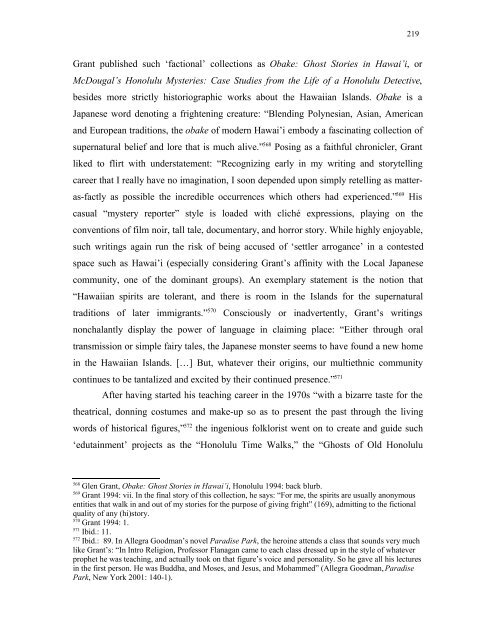A Paradise Lost - KOPS - Universität Konstanz
A Paradise Lost - KOPS - Universität Konstanz
A Paradise Lost - KOPS - Universität Konstanz
You also want an ePaper? Increase the reach of your titles
YUMPU automatically turns print PDFs into web optimized ePapers that Google loves.
Grant published such ‘factional’ collections as Obake: Ghost Stories in Hawai’i, or<br />
McDougal’s Honolulu Mysteries: Case Studies from the Life of a Honolulu Detective,<br />
besides more strictly historiographic works about the Hawaiian Islands. Obake is a<br />
Japanese word denoting a frightening creature: “Blending Polynesian, Asian, American<br />
and European traditions, the obake of modern Hawai’i embody a fascinating collection of<br />
supernatural belief and lore that is much alive.” 568 Posing as a faithful chronicler, Grant<br />
liked to flirt with understatement: “Recognizing early in my writing and storytelling<br />
career that I really have no imagination, I soon depended upon simply retelling as matter-<br />
as-factly as possible the incredible occurrences which others had experienced.” 569 His<br />
casual “mystery reporter” style is loaded with cliché expressions, playing on the<br />
conventions of film noir, tall tale, documentary, and horror story. While highly enjoyable,<br />
such writings again run the risk of being accused of ‘settler arrogance’ in a contested<br />
space such as Hawai’i (especially considering Grant’s affinity with the Local Japanese<br />
community, one of the dominant groups). An exemplary statement is the notion that<br />
“Hawaiian spirits are tolerant, and there is room in the Islands for the supernatural<br />
traditions of later immigrants.” 570 Consciously or inadvertently, Grant’s writings<br />
nonchalantly display the power of language in claiming place: “Either through oral<br />
transmission or simple fairy tales, the Japanese monster seems to have found a new home<br />
in the Hawaiian Islands. […] But, whatever their origins, our multiethnic community<br />
continues to be tantalized and excited by their continued presence.” 571<br />
After having started his teaching career in the 1970s “with a bizarre taste for the<br />
theatrical, donning costumes and make-up so as to present the past through the living<br />
words of historical figures,” 572 the ingenious folklorist went on to create and guide such<br />
‘edutainment’ projects as the “Honolulu Time Walks,” the “Ghosts of Old Honolulu<br />
568 Glen Grant, Obake: Ghost Stories in Hawai’i, Honolulu 1994: back blurb.<br />
569 Grant 1994: vii. In the final story of this collection, he says: “For me, the spirits are usually anonymous<br />
entities that walk in and out of my stories for the purpose of giving fright” (169), admitting to the fictional<br />
quality of any (hi)story.<br />
570 Grant 1994: 1.<br />
571 Ibid.: 11.<br />
572 Ibid.: 89. In Allegra Goodman’s novel <strong>Paradise</strong> Park, the heroine attends a class that sounds very much<br />
like Grant’s: “In Intro Religion, Professor Flanagan came to each class dressed up in the style of whatever<br />
prophet he was teaching, and actually took on that figure’s voice and personality. So he gave all his lectures<br />
in the first person. He was Buddha, and Moses, and Jesus, and Mohammed” (Allegra Goodman, <strong>Paradise</strong><br />
Park, New York 2001: 140-1).<br />
219

















